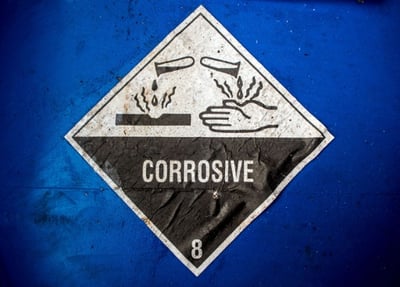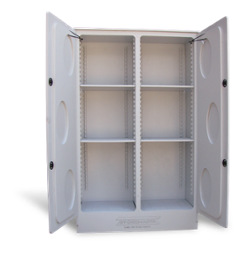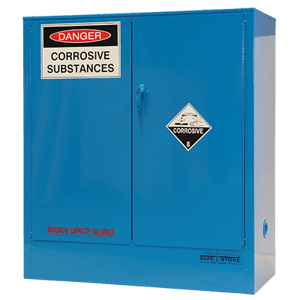If you’re carrying Class 8 Corrosive Substances in your workplace, it’s important that your staff are fully aware of the serious risks associated with their storage and handling. Unlike other classes of dangerous goods, corrosives can damage living tissue, metal and other materials that they come into contact with. Even highly corrosive vapours can cause serious harm to people and property if the concentration of airborne contaminants exceed the workplace exposure standards.
Due to the risks associated with corrosives, there are strict requirements in place for package stores – including how they’re designed, constructed, operated and maintained. In this post, we’ll be highlighting just some of the key considerations you’ll need to make if you’re carrying Class 8 chemicals in your workplace.
Corrosive Substance Storage Requirements
The Australian Standard that details the requirements for Class 8 chemicals is AS 3780 – The storage and handling of corrosive substances.
While the requirements are lengthy and encompass all aspects of indoor and outdoor storage, we’ll be focusing on the storage of corrosives in package stores.
REMEMBER: Any businesses that carry any type of hazardous chemical or dangerous goods has an obligation under WHS Regulations to eliminate, control and manage safety hazards. For Class 8 chemicals, this includes controls to reduce the likelihood and impact of substances and vapours causing harm to people, wildlife, the natural environment, property and vehicles.
What Type Of Package Store Can You Have?
If you’re going to be keeping corrosives at your site, you need to be familiar with corrosive substance storage requirements.

Package stores for corrosives must meet the requirements of the Australian Standards to be deemed safe and compliant.
In Section 4.2 of the Standard, we find the information that relates to the range of package store installations suitable for this chemical class.
These include:
- Room or enclosure within a building
- Indoor storage cabinet
- Roofed structure or room attached to an external wall of another building
- Freestanding, roofed structure or building not attached to another building
- Open air storage facility
IMPORTANT: Every corrosive cabinet, outdoor storage container or store must meet all the requirements of the Australian Standard AS 3780 in order for it to be deemed compliant. Failure to do so can put your staff at risk, as well as potentially putting your business in breach of WHS Regulations.
What Are The Requirements?
Within this package store, corrosive substances must be handled and stored in a way that reduces the risk to people, property and the environment.
Controls must ensure that a range of risks are managed and minimised, including potential leaks and spillage and harmful vapours
Important considerations for the design, construction, use and maintenance of corrosive substance packages stores includes:
Materials Resistant To Chemical Attack
Unlike other types of dangerous goods, corrosive substances can degrade sheet steel. If highly corrosive vapours attack the construction materials or corrosive liquids spill into the store, it can damage the store and render it unsafe and non-compliant.
Therefore, it’s critical that any corrosives storage cabinet or indoor store is constructed to resist chemical attack.

Your Class 8 chemical store must not be susceptible to corrosion from the products stored within it.
The Standards explains, in Section 4.6.5, that:
“The walls, floors, doors and roof of a cabinet shall either be constructed of corrosion-resistant materials or be protected by a corrosion-resistant lining or coating.”
IMPORTANT: Corrosive storage cabinets and stores may be made from polyethylene — or lined with PVC to stop chemical attack. You must refer to the Safety Data Sheet of your chemicals to determine if you require a polyethylene store or one which has a lining on shelves and within the spill containment sump.
Spill Containment
Corrosive package stores must be equipped to contain chemical spillage. The Standards explain that corrosive chemical spillage must be drained into a suitable compliant spill compound.
This compound must be able to hold a specific capacity:
- 25% of the aggregate volume of corrosives kept, or
- the capacity of the largest corrosive container kept
- but not exceed 5000 L where only packages are kept
Concerned about chemical spills?
Construction of the store should also ensure that there’s no pooling of liquids in the spill trays, compounds, shelves and racks.
Racking
For indoor stores, it’s important that the aisles allow for the clear passage of staff. The Standard explains that stores with racking must provide for the escape of personnel. Therefore, the width of the aisles (between the racks) must be at least 1.2 metre for package stores that house corrosive substances.
Ventilation
In storage areas where corrosive packages are opened, mechanical ventilation may be necessary to maintain a safe air quality for workers.
When determining if your store needs ventilation, you must consider the workplace exposure standards for airborne contaminants, as well as your own onsite risk assessment. If you’re at risk of having dangerous levels of corrosive gases and vapours in your store or handling areas, then a mechanical ventilation system may be required.
As with any type of ventilation system in a dangerous goods store, the system must meet further requirements as dictated by the Standards. These include provisions for venting to a safe outside location, extraction from the bottom vent port, and the prevention of vapour emissions escaping the cabinet or system.
Emergency Decontamination Equipment
If there happens to be a mishap or spillage with your corrosive substances, your organisation must be fully equipped to quickly manage the situation.
Therefore, emergency decontamination equipment is required if you have a package store for Class 8 substances where chemical packages are opened. This must be installed 2-10 metres from the store.
Facilities must include:
- Water for hand washing,
- Eyewash facilities; and
- Safety shower or a plunge bath — if there is a lesser degree of risk, a domestic shower may be suitable
REMEMBER: Class 8 chemicals can cause harm to humans through inhalation, ingestion, absorption and direct contact with the skin or eyes. If staff are exposed to corrosive substances, they must quickly utilise emergency decontamination equipment to wash off the substances. If inhalation of corrosive vapours occurs, emergency medical assistance must be provided immediately to reduce the risk of respiratory system damage and fatality.
Dangerous Goods Segregation
The segregation of dangerous goods is a requirement of the Australian Standards. For corrosive substances, this is broken down into two requirements: incompatible substances, and substances that can react dangerously.
Incompatible substances or those that react dangerously must be kept in separate compounds or segregated from corrosive substances. Ideally, a detailed and professional risk assessment of your site will be completed so you can successfully locate your stores at the most applicable distance from other incompatible substances.
For further guidance, see the latest Standard for mixed classes of dangerous goods AS 3833, review your safety data sheets and seek professional guidance from a qualified DG Consultant.
Stacking and Loading Practices
If packages are opened within the store, then the level of airborne contaminants (corrosive vapours) must fall within the legal limits of Safe Work Australia’s workplace exposure standards.
To reduce the risks of leaks and spills, it’s important that complaint spill containment is constructed into the store and that all chemical packages are in good working order, without splits, tears or obvious signs of aging.
Implementing procedures so staff fully understand the features of your cabinet, as well as how to use it properly, will reduce chemical risk.
Stacking and loading of package stores can improve the safety of operations, whilst decreasing the likelihood of a chemical spill. AS 3780 explains that packages should be kept in neat stacks which are not liable to collapse. Therefore, make sure your corrosive packages are stacked in such a way that does not put pressure on lower layers and cause instability of the stack or a splitting of the lower packages.
IMPORTANT: When handling corrosive substances, it’s crucial that your staff have procedures and training in place to minimise human harm. Package stores can be run efficiently and safely if the staff working in the area follow compliant work procedures and receive up-to-date training on both handling and storage of the chemicals.
Housekeeping
Due to the risks associated with the spillage of Class 8 chemicals (harmful vapours, chemical attack of materials and living tissue), the store must be designed, constructed and operated as to allow for housekeeping services to be carried out.
Housekeeping may include the wiping down of shelves and interior walls, the securing of chemical container lids, the wiping of residue from packages, and the cleaning out of the spill containment sump.
Safe Storage and Handling For Corrosives
While we’ve highlighted some key considerations for the storage and handling of Class 8 chemicals, there are many other requirements that relate to corrosive package stores. However, the simplest way to reduce risk instantly is by selecting, installing and using a compliant chemical cabinet. From spill containment to the provision for mechanical ventilation, your cabinet is designed and constructed to reduce the risks associated with corrosives.
If you require assistance with corrosive substances or any other types of dangerous goods, why not access our free eBook? The Risk Assessment Process For Hazardous Chemicals outlines our risk control methodology, which can be easily applied to any workplace. Get your copy today by simply clicking on the below image.
Joining the team as a Dangerous Goods Storage Consultant, Melissa Hampton became Storemasta's Marketing Manager in late 2021. With extensive knowledge and experience in chemical compliance, Melissa is responsible for leading the Marketing team and helping shape their marketing strategy. In her spare time, you can find Melissa hiking, swimming and enjoying the great outdoors in beautiful north-west Tasmania.

